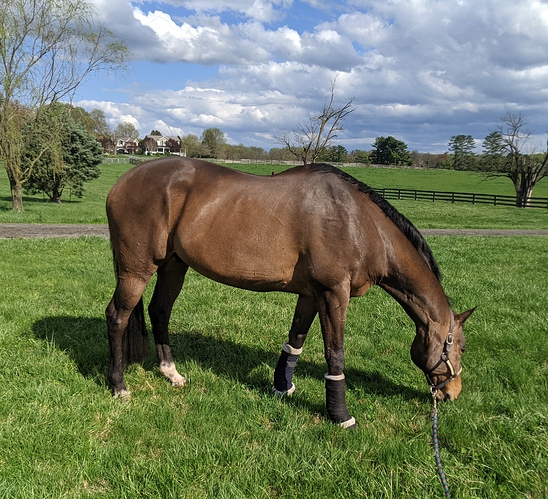My horse has been dealing with a stubborn case of this since December. At the time it turned into full blown cellulitis, which we treated with antibiotics and a steroid, along with sweat wraps, cleaning the leg, etc. The cellulitis cleared up quickly under the vet’s care but the scabby things didn’t go away all the way. She prescribed a cream for the affected pastern, which helped at first, but then it’s effectiveness eventually wore off. The scabs have been on and off since then.
The kicker right now is that my horse has essentially been on stall rest since April 2 with a fractured splint in a different leg. He had the splint surgery last week, and will probably be going back in to a regular turnout schedule in just a few weeks. But the scabs have gotten worse since he started stall rest! I’m wondering if his bedding is causing it. I moved him temporarily to a rehab barn that cleans his stall like 4 times a day, so I know he’s not standing in wet bedding, and he has access to a run that is dry and clean. So I have no idea what to do at this point about his pastern.
I’ve tried all the topicals that people recommend with varying success rates, scrubbing with Betadine, etc. We tried both keeping the hair clipped and leaving it long. I ordered the Silver Whinnies Horse Sox to try next, but once he’s back in a regular turnout schedule I’m not sure those will work/stay on. I need new suggestions.
He currently gets 8 lbs of Purina Impact Pro Performance a day (split up into two feedings) and free choice grass hay. At his home barn he is turned out on a weedy grass paddock for about 12 hours (they feed hay out there too). He also gets soaked alfalfa cubes daily but I’m not sure on the amount. I was feeding him Omega Horseshine, and had temporarily switched to them Omega Horseshine Complete over the winter since it contains vitamin e and a few other things I thought might help with the dermatitis (copper, zinc). He’s back on the regular Omega Horseshine now. His weight, coat, and feet look fabulous, although he has lost a bit of topline in the last few weeks. He is a 17 year old OTTB.
Any suggestions on diet, supplements, new topicals to try, etc. are welcome. His vet is coming next week to remove the staples from his surgery so we will consult on the dermatitis again then as well.


